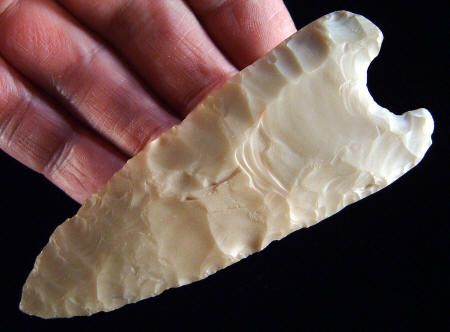|
CLOVIS
POINT
COLBY MAMMOTH KILL SITE
NORTH CENTRAL WYOMING
PRIVATE COLLECTION
COPYRIGHT
JUNE 30, 2009 PETER A. BOSTROM

CAST
#P-80
CLOVIS POINT
COLBY SITE
NORTH CENTRAL WYOMING
This Clovis point was found in 1962 by heavy equipment operator Donald
Colby. He found the point during reservoir construction. The Colby site
was later named after Donald Colby, the discoverer of the site. This is
the largest complete example. A total of four Clovis points were found
on the site. All of the Colby Clovis points have rounded bases.
Frison describes this Clovis point: "The specimen found by Colby is
noticeably different in outline from the classic Clovis type, and part
of this may be the result of reworking. The distal end was reworked for
approximately 11 mm probably to correct for a previously broken tip. The
blade edges expand continually to within about 8 mm from the base, where
they are rounded sharply. A notch 9 mm deep and 15 mm wide is flaked
into the base. The blade edges are ground for just over one-third of
their length, and this joins with the grinding of the deep basal notch.
There is a strong possibility that the base was reworked also and that
the original specimen was longer and that it probably broke distal to
the hafting.
This Clovis point is made of a banded chert that probably came frm
the Madison Formation. It measures 3 5/8 inches (9.2 cm) long.
THE COLBY SITE
CLICK
HERE FOR COLBY SITE PICTURES & HISTORY
The Colby site is located on private property in north central Wyoming in the Bighorn Basin.
This important site was named after Donald Colby who discovered the first
Clovis spear point there in 1962. Mr. Colby found it while using heavy
earth moving equipment during the construction of a reservoir. The Colby site was first recognized
as an important archaeological site when the first scientific
excavations began to take place there in 1973. Most of the site was eventually
excavated during five separate digging seasons between the
years 1973 through 1978.
Parts of at least seven mammoths were found in an
ancient arroyo (dry gully or stream) in two
areas designated as bone pile number 1 and bone pile number 2. There was
also a third much smaller bone concentration that consisted of a variety
of different mammoth bones. It's believed that due to the difference in
the preservation of the bones that the mammoths were probably not all
killed at the same time. The two larger bone piles were found to be
in direct association with a small collection of Clovis related stone
and bone artifacts. New dating estimates for Clovis could place this
site as early as 14,000 years ago. Other types of animal bones found on
the Colby site include horse, camel, bison, pronghorn,
jackrabbit and possibly musk-ox.
|
